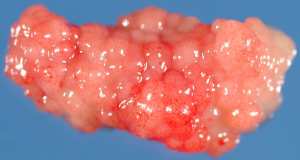

MedFriendly®


Botryoid
Botryoid means having many rounded knobby
outgrowths resembling a bunch of grapes, such as
certain types of cancer. Cancer is an abnormal growth
of new tissue characterized by uncontrolled growth of
abnormally structured cells that have a more primitive
form. An example is a botryoid sarcoma (aka sarcoma
botryoides or botryoid rhabdomyosarcoma) which is a
type of cancer that can be seen in the nasopharynx,
urinary bladder, female genitalia, and the common bile
duct, usually in children under age 8.
A botryoid tumor.
FEATURED BOOK: Anticancer: A New Way of Life
The nasopharynx is the part of the pharynx that lies above the soft palate. The pharynx
is a passage that connects the back of the nose and mouth to the esophagus. The soft
palate is the back part of the roof of the mouth. Bile ducts are tubes that allow bile to flow
through it. Bile is a bitter, yellow-green substance released from the liver that carries
away waste products.
Another example of a botryoid mass is a botryoid odontogenic cyst, which is a type of
cyst present in the mouth that appears grape-like in structure. A cyst is an abnormal
lump, swelling, or sac that contains fluid, a part solid material, or a gas, and is covered
with a membrane. A membrane is a thin layer of flexible tissue that covers something. A
picture of a botryoid cancer is shown above, which clearly shows the grape like form that
these masses can take. Botryoid is also known as uviform and staphyline. Botryoid
comes from the Greek word “botryoeides” meaning “like a bunch of grapes.”
"Where Medical Information is Easy to Understand"™















